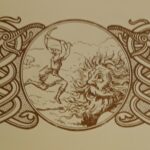
A visit to the Museum of Childhood’s archive one afternoon uncovered a forgotten Scottish Victorian children’s writer. Here, Sarah introduces the fairytale, folkloric worlds of Mona Paton…
*
In 1871, Charles Dodgson, or Lewis Carroll, paid a visit to the island of Arran to see the Edinburgh painter, Joseph Noel Paton, bearing a letter of introduction from George MacDonald. Paton had a reputation as a distinguished artist of religious and mythic subjects but it was as a painter of beautiful and bizarre fairyscapes that he had piqued Carroll’s interest. Though John Tenniel’s images for the Alice books are now much loved, it was Paton whom Carroll had initially wanted as an illustrator for Wonderland’s first publication two years prior.
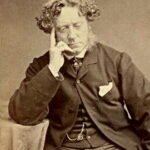

Despite it being a ‘rainy and misty’ September day, Carroll records that he had a delightful time with Paton, his wife, Maggie, and their large family who were holidaying, as they frequently did, on Scotland’s west coast. This marked the beginning of a long-standing acquaintance with one of Paton’s daughters, Mona Margaret Noel (1860-1928), who was then eleven years old.[i] In a later memoir, Joseph Noel Paton’s granddaughter gives this lovely description of Mona as having:
more than her share of artistic temperament (the ‘DAT’ as those of the family who suffered from it most, called it). High-spirited, determined (sometimes pigheaded), a gifted teller of tales, a not unaccomplished pianist, a sweet singer, a clever mimic, Mona also had ‘the sight’. She grabbed life with both hands and thereby suffered much. Her appearance was striking. She adored her father and, with hair waving crisply back from her forehead, appears in a number of his paintings, sometimes as angel, sometimes as devil’.[ii]
Mona, for instance, is known as ‘the curly headed imp’ who appears as a group of wild yet cherubic fairy children (three of her siblings) in one of Paton’s most popular paintings, ‘The Fairy Raid’.[iii]
Eighteen years later Mona would have a volume of fairy tales published by a small Edinburgh printer — retellings of Beauty and the Beast and Jack the Giantkiller. The former is essentially drawn from the literary fairy tale culture of seventeenth- and eighteenth-century France, particularly associated with women writers, though stories of forbidden, ‘monstrous’, or cross-species desire go deep in terms of cultural and historical lineage (the tale of Cupid and Psyche, for example). The latter, on the other hand, springs out of indigenous folkloric and popular tale traditions of the British Isles.
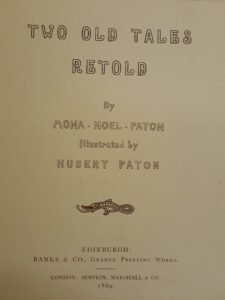
This is a beautiful book — sharp, funny, tender, and bizarre — but scarcely well-known, forgotten amongst a plethora of Victorian fairytale literature. But amidst the depth of a dusty box in the Museum of Childhood’s archive it surfaced one day. With a pale ivory background, text and image in what might best be termed a ‘rusty’ or garnet-coloured ink, and marginal embellishments at the top and foot of each page in neo-Celtic design, 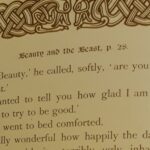 Paton’s book was designed to have an ‘antique’ feel even then. Read in an afternoon, it convinced us that Mona Margaret Noel Paton deserves her own place in the history of Scottish children’s literature.
Paton’s book was designed to have an ‘antique’ feel even then. Read in an afternoon, it convinced us that Mona Margaret Noel Paton deserves her own place in the history of Scottish children’s literature.
Here, then, is a little taste of how she reimagines such two ‘very old’ fairy tales….
*
A fairytale inheritance Paton’s story nearly fails to begin. The narrator almost refuses the demands of a garrulous fairy — whom she meets, naturally, at the bottom of her garden — eager to use her as his scribe for the tale of Beauty and the Beast which he has a burning desire to narrate. But why, she asks bluntly, when ‘[e]very child is sick of it’, trying to put a stop to the fairy’s loquacity, and with a playful nod to a fairytale-saturated children’s book market. Persuaded, however, that there might be some new twists to a well-worn tale, the narrator consents to be his amanuensis. The narrative then takes pleasure in drawing attention to its own craftedness, peppered with little written inscriptions and hallmarks; allusions to the ‘queer uneven writing’ of the Beast’s threatening letter to Beauty’s father; the fairy’s second story of Jack the Giantkiller needs to be translated into clear ‘modern’ English, otherwise it would be utterly incomprehensible. The very fabric of fairy stories, then, is seen as fashioned out of literally magical, marvellous words.
Novelty and quirkiness Mindful of her own narrator’s scepticism, Paton deftly adds little brushes of innovation and quirkiness. Beauty and her two sisters are brought up by an Irish nurse, kind and indulgent; the sight of Beauty’s father galloping off at full tilt on his ‘old brown mare’ is compared to John Gilpin, the character of a 1782 comic ballad by William Cowper who also perched perilously atop a speeding horse. The Beast himself is imagined as a curious hybrid creature, the ‘loathly son’ of a fairy father and mother which immediately frames him within a medieval tradition of ‘loathly’ creatures who are usually feminine. In the accompanying illustrations — by her first cousin, Waller Hubert — the Beast slightly resembles a rather large menacing squirrel.

The Beast’s palace is inhabited by little goblin creatures which proliferate and emerge out of nooks and crannies, just as they do in Victorian fairy paintings. There are ‘weird regions’ aplenty in ‘Jack the Giantkiller’, including a Gothic castle dungeon littered with skulls from which Jack longs for the ‘clear, green, happy earth’.

And towards the end, we are treated to a rather bizarre Druidic-like shaman and a magic circle of goblins and other creatures which brings to mind the art of one of Paton’s contemporaries, the painter, John Duncan.
Paton’s version of ‘Jack the Giantkiller’ — which first appeared in 1711 as a chapbook printed in Newcastle, enjoyed popularity throughout the eighteenth century and would later resurface in the popular fairy and folktale collections of Andrew Lang and Joseph Jacobs[v] — faithfully retains the tale’s Arthurian context. Jack encounters a son of King Arthur and the narrative culminates in the Arthurian kingdom, with a final triumphant adventure involving two dragons and some demons.
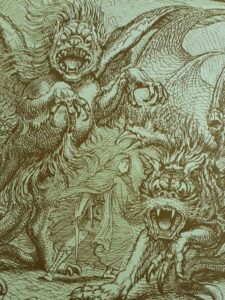
This is entirely appropriate, given that Arthur himself is the giant-slayer of medieval legend. Cornwall and Wales are still the tale’s settings, each rich in its own folkloric and mythic heritage (especially where giants are concerned). Paton’s Jack is brought up near the Welsh border, a ‘land of enchantment’, and her story therefore keeps the specific, localised topography of fairytale terror — St Michael’s Mount, for instance, the home of the child-eating giant called Cormoran (whom Arthur also disposed of).
As well as its little Gothic-studded interludes, and the retention of the folktale’s happy disposition towards violence (Jack ‘plunged the pick into his brain’), there are some lighthearted moments too — Paton has Jack use the Prince’s helmet to make a goose stew; while a flock of princesses, newly ‘disenchanted’ after he kills their captor-giant, squabble over the now apparently highly desirable folk hero.

A feminist fairytale psychology? Paton was probably aware of her seventeenth-century French female precursors in the fairytale tradition when she emphasises the power of Beauty’s intellect and rationality. The conteuses had given life to highly articulate, eloquent heroines who fear diminishment through marriage. Paton’s quiet and reclusive Beauty grows lovelier the more she studies, even patiently teaching her father how to garden. 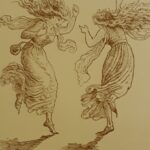 Her archetypally jealous and greedy sisters each find themselves in a loveless, unhappy marriage, a fate almost as bad as their eventual one which is to be magicked into a pair of statues.
Her archetypally jealous and greedy sisters each find themselves in a loveless, unhappy marriage, a fate almost as bad as their eventual one which is to be magicked into a pair of statues.
As ever in the Beauty and the Beast story which has taken familiar shape across the centuries, the love between girl and monster is a lesson in the ‘civilising’ power of female redemption and kindness. Freudian meanings are clearly bubbling beneath the surface. Paton’s Beast is suitably vulnerable and easily wounded — his ‘poor shut-up heart’ is clearly in bad condition.
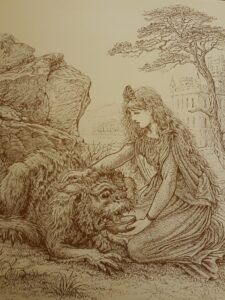
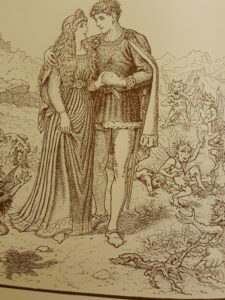
But she adds some delicate psychological touches to her portrait of male fragility. She makes him surprised by Beauty’s kindness, assuming that she would be cruel and unkind to him, just like his mother was. She sees what ‘no-one else had ever seen […] before’. For the first time, under her influence, he discovers ‘respect’ for himself.
Paton is clearly keen to make her fairytale (anti)heroes psychologically explicable. Her Jack protagonist takes up the killing of giants because he is unloved and treated ‘unkindly’ by a surrogate father-figure. In other versions, he has a fairly benign biological father who is usually a farmer. Paton, however, makes Jack’s paternal stand-in a butcher by trade who horrifies the boy by his bloody acts of animal killing. These are small but revealing details which colour in the emotional and moral canvas of Paton’s distinct fairytale world.
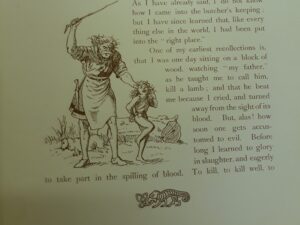
As well as perhaps being an advocate of vegetarianism (like her father’s good friend, George MacDonald), Paton — at least within her creative world[vi] — also views the machinations of erotic desire in a tolerant and compassionate way. ‘People do not need to be quite good for one to love them’, Beauty muses at one point; ‘I think one sometimes loves the bad ones best, they seem to want it most’. If Beauty is cheerfully opening the door to female (and male) transgression here, she still remains pleased that the Beast ‘is making use of her love’. Though this seems a little blunt, part of the Beast’s education is also learning to respect and not to possess her: when he tries to prevent her from leaving to return to her sick father, an interior voice reminds him — ‘Had you any right to expect her to be kind to you? had you any right to expect her to love you even a very little?’
*
In a century crammed full of fairytale inventions and imitations, Paton manages to make the mode her own. These are playful, funny, odd, and beautiful all at once — not quite fitting the moralising mould, gesturing back to the French tradition’s celebration of female intellect and freedom, and expressing sympathy for outsiders, if not giants. Both storyworld and illustration reflect the artistic currencies of neomedieval Arthurianism and ‘Celticism’; they have a folktale spirit suffused with all the ‘weirdness’ of the Victorian fairy aesthetic.
In that sense, she is perhaps quite obviously the daughter of a father who was a poet as well as a painter, nurtured in a bohemian household at 33 George Square in Edinburgh — apparently ‘crowded with curious carvings, old-world paintings, and bric-a-brac, rich tapestries, and old ecclesiastical vestments’ — where Oscar Wilde as well as Lewis Carroll and George MacDonald called. But that would be to make Paton palely imitative, moulded by paternal and familial influences. The Museum of Childhood archive — as with so many of the forgotten books, writers, and lives housed within its boxes — has disclosed that she is much, much more than that.
The last word goes to the enigmatic fairy at the end of Paton’s Jack the Giantkiller as he leaves the narrator, and us, behind:
“tell me,” I asked, “did Jack ever go back to the wood?”
“That he did.”
“And did he find out what he wished to know?”
“Ay! we all find out what we wish to know when we get there.”
And the Fairy was gone.
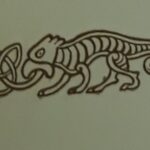
[i] In a letter to The Times (March 27, 1928, p. 12), Paton wrote that: “I have presentation copies of all his books,” she wrote. “He used to annoy me very much by setting me puzzles, and I retaliated by making some paper stars, and refusing to show him how they were done. One of his letters is asking me to send him one little star, so that he might find out for himself. I have also two photographs which he took of me in his rooms at Oxford, and of which I do not approve, as I thought they made me uglier than I was…’: cited in The Letters of Lewis Carroll, 2 vols, edited by Morton N. Cohen, with the assistance of Roger Lancelyn Green, vol 1, footnote 1, p. 166.
[ii] Noel Paton 1821-1901 by M.H. Noel Paton and J.P. Campbell edited by Francesca Irwin (Ramsay Head Press, 1990), p. 26.
[iii] Noel Paton 1821-1901, p. 29.
[iv] He was Joseph Noel Paton’s younger brother, a designer by training who also studied watercolour painting with John Huston and was deeply influenced by the Pre-Raphaelites, he thereafter regularly exhibited his work. Residing at 14 George Square, he had ‘daily contact with his brother until his death’; in a journal entry for 8 March 1895, Paton wrote that ‘few brothers have been so much to each other all through life’: Noel Paton 1821-1901, p. 112.
[v] See T. Green, ‘Tom Thumb and Jack the Giant-Killer: Two Arthurian Fairy Tales?’, Folklore, 118.2 (2007), pp. 123-40; see also Caitlin R. Green, ‘Jack & Arthur: An Introduction to Jack the Giant-Killer’, The Arthuriad, vol 1 (2007; 2015), pp. 1-38. www.arthuriana.co.uk/arthuriad/ Arthuriad_VolOne.pdf, accessed 12th July 2017.
[vi] Mona ‘married J.W. Kidston, vicar of Hampton Poyle, near Oxford, in 1880 and had three children. Originally very happy, the husband and wife proved temperamentally unsuited’: Noel Paton 1821-1901, p. 113.
This post written by Sarah



Wonderful discoveries! Yes, much much more than that!
Thank you so much! She’ll be part of our exhibition….
The illustrations were in fact done by her first cousin, Waller Hubert Paton, and not by her uncle Waller Hugh Paton.
Many thanks indeed for pointing this out – incredibly helpful to know, and will be amended accordingly.